Grosseto and its Territory
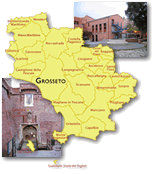
Surrounded by a territory with abundant natural resources, for a long time made inaccessible by malaria, for centuries Grosseto has been the main urban entity of Maremma. The network of canals and coastal swamps that characterised the territory were skilfully exploited as communication and transportation routes, as of the 16th century. At one time, Grosseto was indeed surrounded by a navigable canal connecting it to the sea by means of the swamps that constituted the last evidence of the vast Lake Prile which, in antiquity, spread over the entire plain of Grosseto. Starting in the 19th century, the entire area was subjected to intense reclamation, begun by Vittorio Fossombroni by order of Grand Duke Leopold II, and concluded only in the past century.
[Given the limitations on traffic in the historical centre, we advise you undertake the first legs of the proposed itinerary on foot]
The entire historic center of Grosseto is surrounded by a sixteenth-century curtain wall, one of the best preserved of its kind in Tuscany.
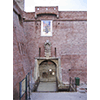
The construction of new massive walls around Grosseto as part of the plans to fortify the new borders of the Medici state, was ordered by Cosimo I following the annexation of Siena and Maremma, around the mid 16th century. In particular, the necessity to fortify Grosseto lay in the political and strategic importance of the city, location of a large store of grain and salt, both produced in the area.
Walls already surrounded the city in the Middle Ages, and were rebuilt several times by the Republic of Siena. Around 1540, Anton Maria Lari reinforced the walls of Grosseto with modern angular bastions. Due to the bad conditions of Grosseto’s fortifications after its annexation to the Medici state, the construction of new walls began in 1565 on a project by military architect Baldassarre Lanci and ended around 1593. The walls of Grosseto are hexagonal in shape with bastions at the top. Internally, its perimeter is skirted by a ring-walk, and externally by navigable canals, used during construction also to transport materials. The brick structure responded to the principles of then modern military architecture. The Medici fortification contains several elements of the medieval walls: the Porta Vecchia (old gate) to the south, the only access to the city until 1754 when the Porta Nuova (new gate) was opened to the north, and the Sienese keep (1345), made of squared travertine stones, englobed into the bastion of the Fortress, a massive construction with military functions, made up of barracks, storehouses and a chapel.
The fortification was transformed in 1828 by order of Grand Duke Leopold II of Lorraine, adapting the bulwarks and ramparts into public gardens and lanes, definitively divesting the walls of their military function.
(Graziano Magrini)
The fourteenth-century Sienese Keep, englobed into the circuit of walls, houses the Museo Virtuale "Oltre i confini", a small but original educational multimedia exhibition that traces back local history and culture.
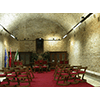
Situated on the premises of the fourteenth-century Cassero Senese at Grosseto, this small multimedia museum aims to stimulate the interest of young visitors in the city and its territory. Various thematic itineraries (a sound tunnel, a boat and the marsh, a bird-watching post) combined with interactive posts, provide a deeper knowledge of the historical, scientific and cultural aspects linked to the flourishing naturalist environment of the reclaimed land once covered by Lake Prile.
(Elena Fani)
Backtracking towards Via Corsini, a worthwhile stop is the Museo di Storia Naturale della Maremma whose collections offer a complete panorama of the palaeontological and mineral wealth of southern Tuscany, including an interesting collection of fossil shells.
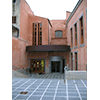
The origin of the Museum dates from 1961, the year in which the Commune granted to the Naturalist Speleological Association of Maremma a temporary site in which to keep its collections. But it was only thanks to the success of an exhibition held in 1967 that it was decided to create a Museum of Natural History, which has been open to the public since 1971.
The naturalist specimens, coming for the most part from southern Tuscany, are divided into various sections: rocks and minerals, insects, seashells, birds, reptiles and amphibians, mammals and palaeontological findings (fossilised bones and shells).
(Elena Fani)
Walking down Via Garibaldi in the historical centre and then turning right onto Via Ginori, you come to Piazza Indipendenza where you can see the hydraulic structures built in the early 19th century for the construction of a Large Cistern, intended to supply the city with drinking water.

The Lorraine Grand Dukes paid particular attention to realising works of hydraulic engineering, which were indispensable to solve the serious problem of water supply in several areas of Tuscany.
As had already occurred for Livorno, a "Cisternone" was also realised in Grosseto. Emanuele Repetti gives an effective description: «It is indeed necessary to add that in order to supply the capital city of Maremma with fresh and healthy waters, in 1830 the August Sovereign [Leopold II] had one of those large machines used to drill the so-called artesian wells transported to the largest square of Grosseto (Piazza del Duomo). The work produced such an effect that following constant labour lasting several months, and drilling to a depth of about 210 arms, from beneath that immense antediluvian and post-diluvian deposit, there gushed forth copious drinking water, fresh and perpetual, which rose up to eight arms beneath the present level of Grosseto. Two shafts surrounded by a charming little Gothic temple, worked with iron wrought in the furnaces of Follonica [grand-ducal foundry], indicate to the present and future generations one of the many and superlative benefits of Leopold II in favour of the population of Grosseto».
In 1846, in order to make room for the monument dedicated to Grand Duke Leopold II of Lorraine, the parts of the little temple were disassembled and reassembled at Arcidosso.
(Antonella Gozzoli)
Leaving Grosseto on SS223 and proceeding towards Siena, after about 10 kilometres, you come to a junction indicating the Roselle Archaeological Area, which offers the visitor several significant examples of engineering solutions adopted in the Etruscan and Roman world.
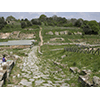
Inhabited since the 7th century B.C. and definitively abandoned only in the 17th century, Roselle is one of the largest visitable archaeological areas in Tuscany.
From a technical-scientific viewpoint, the most interesting aspect lies in the massive Etruscan walls (built in the mid 6th century B.C. and reworked in later periods), the entire perimeter of which has survived and measures 3270 metres. Recent restoration has shed light on its technical features. The criteria followed in choosing the building materials (calcareous rock, sandstone and marl) were essentially based on the nearness of the sites of extraction to the worksites, as several still distinguishable quarries near the walls would seem to prove. Externally, the wall was built with a polygonal plan, with large irregularly shaped blocks laid onto the rock, specially levelled to guarantee stability. Its irregular profile was then evened with the addition of small nogs functioning as wedges. The internal facade was instead formed by smaller stones. Finally, the central part between the two faces was filled with a combination of earth and flaked rock, probably to assure good drainage.
Today’s visitor can take the footpath along the walls, which are especially visible on the northern side, where some of the structures have preserved up to five metres of their original height.
Again from the scientific viewpoint, the Roman remains too, offer interesting evidence of the technical knowledge of the ancients, especially in the fields of building and hydraulic engineering. One need only consider the large pool, more than two metres deep, of the baths dating to the age of Hadrian, on the slopes of the hill north of Roselle, or the monumental cistern in masonry dating to the imperial age, waterproofed with a layer of potsherd and still visible on the hill south. Also of great interest are the numerous, well-preserved segments of paved road which crossed town: of these, the cardo maximus still shows the ruts produced by the passage of carts, as opposed to the decumanus, which must have been used exclusively by pedestrians. Restoration performed in the past 20 years has exposed the differences of the road surface which ranges from a pavement formed by large river cobbles (via glareata) to a flagstone pavement made of large irregular polygonal blocks (via silicata) near the Roman forum, fitted into place and embedded in a cement preparation over a beaten earth bed.
(Elena Fani)
A natural addition to an itinerary through Grosseto and its territory can not but include Scansano which, since the second half of the 19th century, every summer hosted the administration offices and the high society of Grosseto. This explains why this little town, reachable via SP159/SS322, boasts a theatre of extraordinary dimensions like the Teatro Castagnoli.
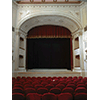
The salubrious location of Scansano, far from the unhealthy swamps of the Maremma plains, made this town one of the most important centres of southern Tuscany, delegated, in the 19th century, to accommodating the government offices stationed at Grosseto during the summer months. It is for this reason that we find at Scansano such an important building as the Castagnoli Theatre, whose construction took almost 40 years. Upon completion of the work, in 1891, the hall had an ovoidal bell shape, a loggia with arches and a balcony, according to a model typical of French theatres, and rather unusual in Italian theatres of the time, which were usually constructed with boxes.
Converted to a movie theatre after World War II, it was restored in the last twenty years of the past century, returning to serve its original function.
(Elena Fani)
The pleasant hill town also hosts an interesting museum that illustrates wine culture and the procedures for making the precious nectar, from antiquity up to the 20th century.
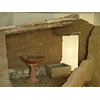
Founded in the Palazzo Pretorio at Scansano, the Museum aims to promote the culture and traditions of the territory inherent to wine production. The exhibition is made up of five different sections: historical area (archaeology of wine); production area; "grapevines and wine cycle" area; traditions area (wine-tasting laboratory); and information area. The Museum is the headquarters of the Associazione "Strade del Vino Colli di Maremma" ["Maremma Hills Wine Roads" organisation], which offers food and wine tours of the territory.
(Elena Fani)
****************************
Texts by Elena Fani
English translation by Victor Beard
Last update 09/ott/2008



 = libraries and archives
= libraries and archives  = scientific research centers
= scientific research centers  = memorial places of scientists
= memorial places of scientists = public health places
= public health places = places of science and worship
= places of science and worship = places of technology
= places of technology  = museums and collections
= museums and collections  = villas and gardens of science
= villas and gardens of science

